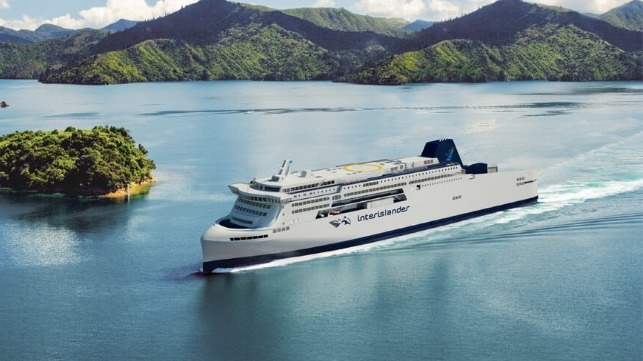KiwiRail and Hyundai Terminate Ferry Order After Government Declines Funds

KiwiRail and Hyundai Mipo Shipyard are involved in talks after agreeing to terminate the 2021 construction contract for two large ferries designed to modernize New Zealand’s inter-island transport service. The termination comes after the New Zealand government decided in December 2023 not to provide funding to the project after years of development and casting doubt on the service.
The company currently operates three ferries the oldest of which was built in 1988 while the others were built in 1995 and 1998. The ferry service operates more than 4,000 crossings between the North and South islands each year and according to company data moves US$8.5 billion in freight annually. The three vessels are Ro-Ros with one able to also transport rail cars. Each year the company says it transports nearly 800,000 passengers and 250,000 cars.
Hyundai reported today in a stock exchange filing that the contract valued at US$313 million to build two ferries was canceled at KiwiRail’s request. The shipbuilder says it will see a claim for design costs as part of its negotiations. In a separate statement, KiwiRail confirmed it has now started discussions with Hyundai Mipo for the termination.
The company reports it will look at alternatives including discussions with international shipbrokers on the options to source suitable replacement ferries. At the same time, the government plans to launch an advisory group to provide independent advice on the options for the Cook Strait ferry service. They plan to review the long-term intern-island service requirements and future options.
The company had gone public in 2020 with its plans while continuing to detail the design program through 2022. They had called for two much larger ferries to enter service in 2025 and 2026. Each would have been 50,000 gross tons with a capacity for more than 1,900 passengers versus the current ships which have a maximum capacity of 650 passengers. They would also have accommodated 650 passenger cars versus the current 250.
The design called for a hybrid electric ferry that would incorporate batteries storing power from shoreside charging stations along with an integrated electric propulsion system. The batteries would have had the capacity to power about 30 percent of the three-hour journey ensuring that the ferries would operate with zero emissions in port and while maneuvering. Key suppliers had been selected with Hyundai Mipo, including Kawasaki Heavy Industries for the vessels’ thrusters and Mitsubishi Heavy Industries for fin stabilizers. Siemens Energy was providing the Electric Propulsion System and the vessels were to be propelled by pods.
Without government funding, KiwiRail said it was unable to proceed and in December reported it would begin to wind down the project. They also launched a review of the plans for the Cook Strait connection.
Last month, New Zealand regulators openly called into question the company’s operating and maintenance programs for the aging ferries. They reported they were planning to prosecute the company for a 2023 blackout aboard one of its ferries. Inspectors found the vessel was using outdated spare parts and not following maintenance schedules. News of the plan to bring charges against KiwiRail also renewed the debate over the ferry replacement program.
No comments:
Post a Comment